AE-Lock (Auto-Exposure Lock) Photography
A function to temporarily
store the exposure setting determined by the camera in memory. After measuring the
light at a specific portion of the subject (face, etc.) or another object, you can
change the angle as desired, maintaining the exposure setting (AE lock is activated
with the AE button). When the subject is backlit, first direct the camera to a dark
area or fill the frame with the subject for AE lock, then return the camera to the
desired angle and framing to shoot.
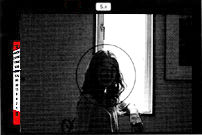 |
AE-Lock photography is possible in Aperture- Priority Auto (A) mode. You cannot use it in Manual (M) mode. Since the composition of a shot can be changed with the EV stored temporarily in memory, AE-lock photography using a subject of normal (intermediate) brightness proves to be highly effective when you shoot with back lighting that makes it difficult to specify the exposure, or when subjects of high and low reflectance are intermingled in the viewfinder. |
In many ways,
AE Lock is more functional and easier than using exposure compensation as it is more
accurate and less demanding for call for experience especially when dealing in difficult
lighting. The only thing to remember is, work in close and ensure a big portion of
the subject fills up the 12mm metering reference circle inside the viewfinder.
1). Locate the subject in the center of the viewfinder and get it in focus.
2). Lightly press the shutter-release button.
3). Press; the AE-lock button.
4). Compose your shot, and shoot with the AE-lock button held pressed.
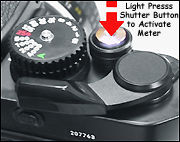 |
 |
 |
* Apply the auto exposure lock when the exposure meter is active.** The exposure-meter indicator in the viewfinder is fixed in AE-Lock mode. |
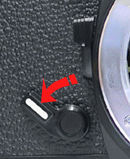 |
Self-Timer Photography |
The countdown time of the self-timer can be set in the range of 4 to 10 seconds, according to how far you cock the self-timer lever. You can cancel self-timer operation after you set it. To cancel, pull the lever back toward the lens completely until it stops before you press the shutter-release button. (It you pull the self-timer lever back when it is already in operation, the shutter is released the moment the lever reaches its original position). Another very good usage of Self Timer with the FM3A is when you are engaged with some assignments that demand absolute minimal camera movement such as extreme macro, super telephotography and astrophotography (works with a tripod) because the reflex mirror will immediately flips up when the timer is activated. This minimizes the chances of getting any movement caused by mirror bounce when operating at slower shutter speed(s).
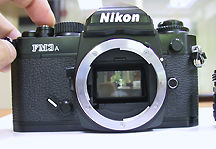 |
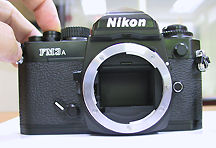 |
Caution: When you shoot without looking through the viewfinder in Aperture-Priority Auto mode, cover the eyepiece to prevent interference from stray light when you press the the shutter-release button. |
Multiple-Exposure Photography
Exposing a single frame more than once to overlap multiple images is called multiple-exposure photography.
 |
If images are to be overlapped in the background, exposure compensation is required, depending on the number of exposures in multiple-exposure photography. (When images do not overlap, no compensation is necessary.) |
|
Number of exposure |
2 |
3 |
4 |
8 or 9 |
|
Standard compensation value |
-1.0 EV |
-1.5 EV |
-2.0 EV |
-3.0 EV |
DO not attempt to advance film yet for multiple-exposure photography until you memorize the exact frame number before the operation. First, wind the film-advance lever (2) while holding the multiple-exposure lever (1) toward you. As the film does not advance, the frame counter does not count up. Frames may shift slightly in some multiple-exposure photography. In particular, multiple-exposure photography using the first or last frame of a film roll is not recommended, as film advance may be slightly unstable at the beginning and end of a roll.
Note: An exclusive feature
that found on the Nikon SLRs, It is also possible to use the multiple exposures in
combination with a Motor Drive or power winder to achieve certain creative effect.
Additional Information
Shutter
Speed
and Aperture
Setting
(More information is available in the PIM site
on this specific topic)
The shutter-speed setting lets you specify the length of time the film will be exposed
by opening/closing the shutter curtains, and the aperture setting gives you control
over the amount of light that passes through the lens. The value to indicate this
exposing is called "EV" (Exposure Value)*. The condition using
ISO 100 film with shutter speed of one second and an aperture setting of f/1.0 is
defined as EV0, which increases by one each time the aperture is stopped down or
the shutter speed is increased by one unit.
* EV is a display method to
indicate exposure values, where the condition with ISO 100, aperture of f/1.0, and
shutter speed of one second is defined as EV0. The EV value relatively increases
by one each time the aperture or the shutter speed is increased by one unit. The
aperture and shutter speed are indicated in the built-in exposure meter of the camera
as values converted from the EV value.
The shutter speed and the aperture value converted from the EV value are displayed
in the viewfinder of the camera. The same EV value can result from various possible
combinations of shutter speed and aperture setting. For example, as shown in the
EV table below, when the correct exposure is obtained with a shutter speed of 1/125
second and an aperture setting of f1 1 (EV14), you can obtain the same amount of
light also at 1/60 second and f16 or at 1/250 second and f8, for the correct exposure.
Understanding these combinations, you can change only the effect on the picture by
changing the combination of shutter speed and aperture setting without changing the
exposure.
 |
The shutter speed setting lets you specify the length of time the film is exposed, and the aperture gives you control over the amount of light that passes the lens. Different combinations of shutter speed and aperture setting can be selected to provide the same exposure. Priority should be given to shutter speed when movement is more important, and to the aperture setting when depth of field is more important. |
Previous | Next | 7/8 Depth of Field, Light-Metering Methods, Optional Accessories: MD-12 Motor Drive, SB-27 Speedlight, MF-16 Data Back, Camera Case, Filters for B&W and Color Film, a new Nikkor lens 45 mm F/2.8P Lens, Neck Straps, Cable Release, Eyepiece Correction Lens, DB-2 Anti-Cold Battery pack, DG-2 Eyepiece Magnifier, DR-4 Right-Angle Viewing Attachment
| Back | Index Page of Instruction Manual Section of Nikon FM3A
| Other Issues relate to Nikon
FM3A | < Index Page
>
| Instruction Manual for Nikon FM3A |
| Technical Specification | Main
Reference Map
|
Standard
production Nikon FM Series models:-
Nikon FM | Nikon FM2 | Nikon FM2n | Nikon FM10 | Nikon FM3a |
Known
variants:-
Nikon
FM Gold
| Nikon
FM2/T
| Nikon
FM2N Tropical Set
| Nikon
FM2/T Limited Edition
| Nikon
FM2N LAPITA
|
Nion
FM2n Millennium 2000
| Message Board | for
your favourite Nikon
FM Series SLR models
| Message
Board | for your Nikon
Optics in a shared environment
| Message Board | Specifically for Dispose or Looking for Nikon/Nikkor
Photographic Equipment
| Back | Main Index Page of Nikon FM series Bodies
Shared Resources: MD-11 | MD-12 | Focusing Screens | Titanium Shutter | ORIGINAL dedicated Flash Units -SB-16 | SB-15 | SB-10 or other Options | Databack | Nikkor lens mount (related info)
Others:- Nikon AF-TTL Speedlights
| SB-20 (1986)
|
SB-22
(1987)
| SB-23 | SB-24 (1988) |
SB-25 (1991/2) |
SB-26 (1994)
| SB-27(1997)
| SB-28 (1997) |
Nikon
SB-29(s)
(2000) |
Nikon
SB-30
(2003) |
Nikon
SB-600
(2004) |
Nikon
SB-800 (2003)
(updated)
Nikon AF-TTL Speedlight DX-Series: Nikon SB-28DX (1999)
| SB-50DX (2001) |
SB-80DX
(2002)
(updated)
Nikon
BC-flash Series |
Original Nikon Speedlight
SB-2
| SB-3
| SB-4
| SB-5
| SB-6
| SB-7E
| SB-8E
| SB-9
| SB-E
| SB-10
SB-11
| SB-12 | SB-14 | SB-140 UV-IR| SB-15 | SB16A | SB-17 | SB-18, SB-19 | SB-21A (SB-29) Macro flash | Flash Accesories | SF-1
Pilot Lamp
Instruction
Manual: Nikon FM (HTML | PDF) | Nikon FM-10 (HTML) | Nikon FM2n's
User's Manual
available only in HTML format (6
parts) | Nikon FM3A (HTML)
Specifications: Nikon FM, FM-10, FM2, FM2n and FM3A
Main Reference Map: (HTML) Nikon FM, FM2, FM-10, FM2n (Applicable
to FM2T, FM2 "Year of the Dog"; Millennium 2000") and FM3A
| Nikon F | Nikon F2 | Nikon F3 | Nikon F4 | Nikon F5 | Nikon F6 | Nikkormat / Nikomat | Nikon FM | Nikon FE/ FA | Nikon EM/FG/FG20 | Nikon Digital SLRs | Nikon - Other models |
Nikon Auto Focus Nikkor lenses:- Main Index Page
Nikon Manual Focus Nikkor lenses:- Fisheye-Nikkor Lenses - Circular | Full Frame |
Ultrawides Lenses - 13mm15mm18mm20mm | Wideangle Lenses - 24mm28mm35mm | Standard Lenses - 45mm 50mm 58mm | Telephoto
Lenses - 85mm105mm135mm180mm & 200mm | Super-Telephoto Lenses - 300mm 400mm 500mm 600mm 800mm 1200mm |
 Index Page |
Special
Application lenses: Micro-Nikkor Lenses - 50mm~55mm -60mm 85mm -105mm 200mm Micro-Zoom 70-180mm Perspective Control (PC) - 28mm 35mm PC-Micro 85mm Dedicated Lenses for Nikon F3AF: AF 80mm f/2.8 | AF 200mm f/3.5 EDIF Depth of Field Control (DC): 105mm 135mm Medical Nikkor: 120mm 200mm Reflex-Nikkor Lenses - 500mm 1000mm 2000mm Others: Noct Nikkor | OP-Nikkor | UV Nikkor 55mm 105mm | Focusing Units | Bellows-Nikkor 105mm 135mm Nikon Series E Lenses: 28mm35mm50mm100mm135mm | E-Series Zoom lenses: 36~72mm75~150mm70~210mm |
MF Zoom-Nikkor Lenses: 25~50mm | 28~45mm | 28~50mm | 28~85mm | 35~70mm | 36~72mm E | 35~85mm | 35~105mm | 35~135mm | 35~200mm | 43~86mm | 50~135mm | 50~300mm | 70~210mm E | 75~150mm E | 80~200mm | 85~250mm | 100~300mm | 180~600mm | 200~400mm | 200~600mm | 360~1200mm | 1200~1700mm
Tele-Converters: TC-1 | TC-2 | TC-200 | TC-201 | TC-300 | TC-301 | TC-14 | TC-14A | TC-14B | TC-14C | TC-14E | TC-16 | TC-16A | TC-20E
Recommended links to understand more technical details
related to the Nikkor F-mount and production Serial Number:
http://rick_oleson.tripod.com/index-153.html by: my
friend, Rick Oleson
http://www.zi.ku.dk/personal/lhhansen/photo/fmount.htm by: Hansen,
Lars Holst
http://www.mir.com.my/rb/photography/hardwares/nikonfmount/lens2.htm
http://www.photosynthesis.co.nz/nikon/serialno.html
W A R N I N G: The New G-SERIES Nikkor lenses have no aperture ring on the lens, they CANNOT ADJUST APERTURES with any of these manual focus Nikon FE series SLR camera models; please ignore some portion of the content contained herein this site where it relates.
|
Back | Main Index Page of Nikkor Resources
|
Back | Main Index Page of Pictorial
History of Nikon SLRs
| Message Board | for your Nikkor optics ("shared" because I do wish some of you to expose to other's perspective as well. Isn't it a sad sate to see photography has to be segmented into different camps from the use of various labels)
about this photographic web site
Home - Photography in Malaysia |
Credit: To all the good people who has contributed their own experience, resources or those who are kind enough granting us permission to use their images appeared in this site. Mr. MCLau®, who has helped to rewrite some of the content appeared this site. Chuck Hester® who has been helping me all along with the development of all these Nikon websites;LarsHolst Hansen, 'Hawkeye' who shares the same passion I have; Ms Rissa, Sales manager from Nikon Corporation Malaysia for granting permission to use some of the official content; TedWengelaar,Holland who has helped to provide many useful input relating to older Nikkor lenses; Some of the references on production serial numbers used in this site were extracted from Roland Vink's website; HiuraShinsaku from Nikomat Club Japan. t is also a site to remember a long lost friend on the Net. Note:certain content and images appeared in this site were either scanned from official marketing leaflets, brochures, sales manuals or publications published by Nikon over the years and/or contribution from surfers who claimed originality of their work for educational purposes. The creator of the site will not be responsible for may discrepancies arise from such dispute except rectifying them after verification."Nikon", "Nikkormat", "Nippon Kokagu KK" & "Nikkor" are registered tradename of Nikon Corporation Inc., Japan. Site made with an Apple IMac.